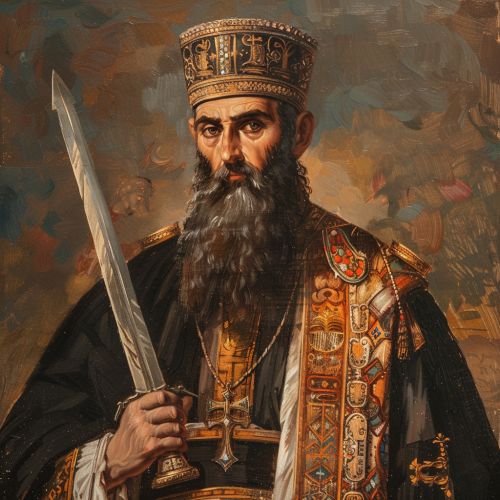Spatharios
Introduction
The term "Spatharios" (Greek: σπαθάριος) refers to a specific rank and title within the Byzantine Empire. This title, which translates to "sword-bearer," was initially used to denote a member of the imperial guard who was responsible for carrying the emperor's sword. Over time, the role and significance of the Spatharios evolved, reflecting the changing military and administrative structures of the Byzantine state.
Historical Background
The origins of the Spatharios can be traced back to the early Byzantine period, specifically during the reign of Emperor Constantine the Great (r. 306-337 AD). The title was initially a military designation, given to elite soldiers who served in the imperial guard. These soldiers were tasked with the personal protection of the emperor and were often chosen for their loyalty and martial prowess.
As the Byzantine Empire expanded and its administrative structures became more complex, the role of the Spatharios also evolved. By the 7th century, the title had become more ceremonial, often granted as an honorific to distinguished individuals within the military and civil administration.
Duties and Responsibilities
The primary duty of a Spatharios was to serve as a bodyguard to the emperor. This role required not only physical strength and combat skills but also unwavering loyalty to the emperor. Spatharioi were often stationed in the imperial palace and accompanied the emperor on various state functions and military campaigns.
In addition to their protective duties, Spatharioi also played a role in the ceremonial life of the court. They participated in various state rituals, processions, and religious ceremonies, often carrying the emperor's sword as a symbol of imperial authority.
Evolution of the Title
Over the centuries, the title of Spatharios underwent significant changes. By the 9th and 10th centuries, the title had become largely ceremonial, often granted as an honorary distinction to high-ranking officials and military commanders. The title was also used as a reward for loyalty and service to the emperor, reflecting the Byzantine practice of rewarding merit and loyalty with titles and honors.
Notable Spatharioi
Several notable individuals held the title of Spatharios throughout Byzantine history. One such individual was Nikephoros Phokas, a prominent military commander who later became Emperor Nikephoros II Phokas (r. 963-969 AD). His tenure as Spatharios was marked by significant military achievements, including the successful campaigns against the Arabs in the eastern provinces of the empire.
Another notable Spatharios was Basil II (r. 976-1025 AD), who served as a Spatharios before ascending to the throne. His reign is often considered one of the most successful in Byzantine history, marked by military conquests and administrative reforms.
Iconography and Symbolism
The Spatharios was often depicted in Byzantine art and iconography, usually shown carrying a sword or standing guard near the emperor. These depictions served to emphasize the close relationship between the Spatharios and the emperor, as well as the symbolic importance of the sword as a representation of imperial power and authority.


Decline and Legacy
The title of Spatharios gradually declined in significance during the later Byzantine period. By the 12th century, the title had become largely obsolete, replaced by other titles and ranks within the Byzantine military and administrative hierarchy. However, the legacy of the Spatharios continued to influence the ceremonial and military traditions of the Byzantine Empire, reflecting the enduring importance of loyalty and service to the emperor.
